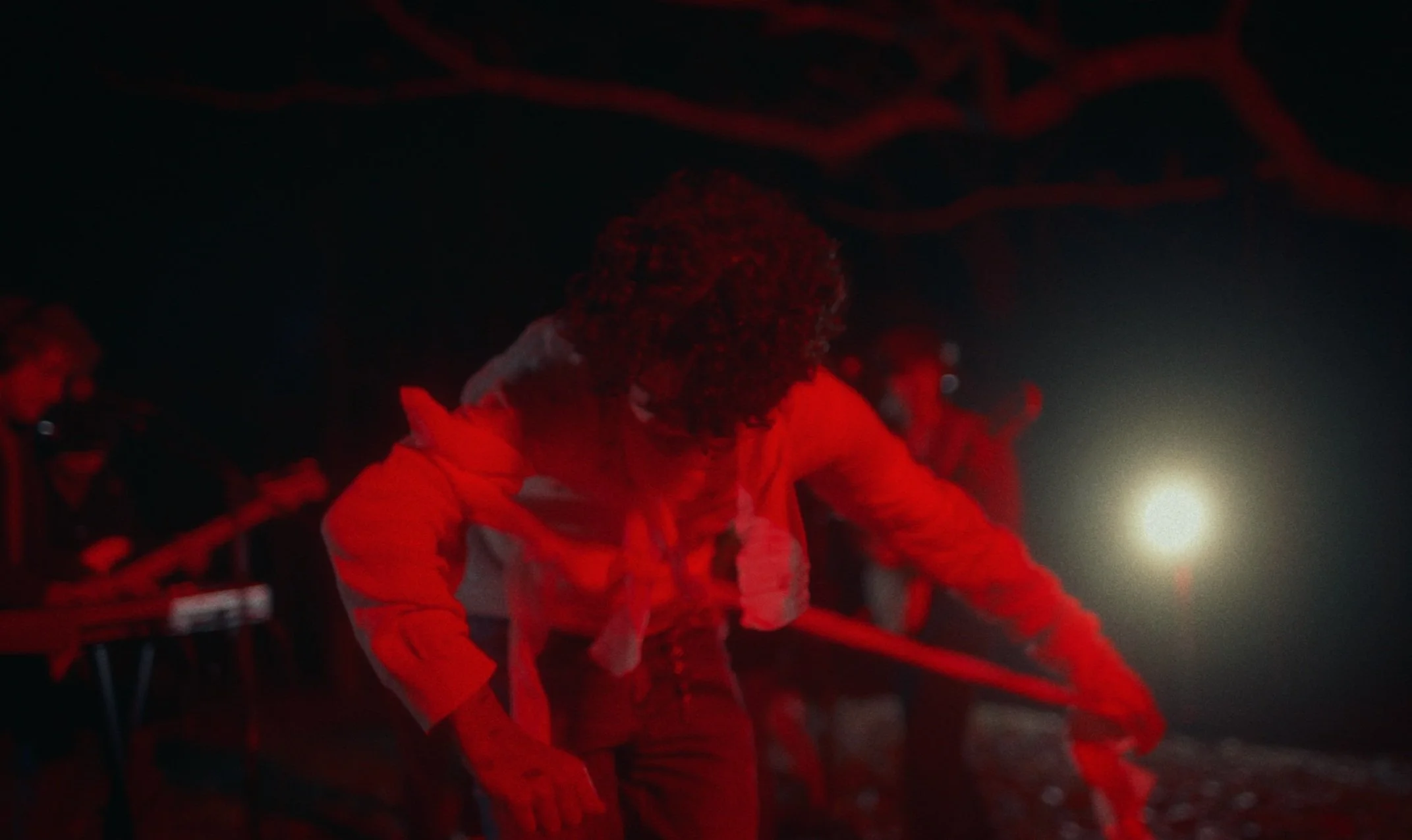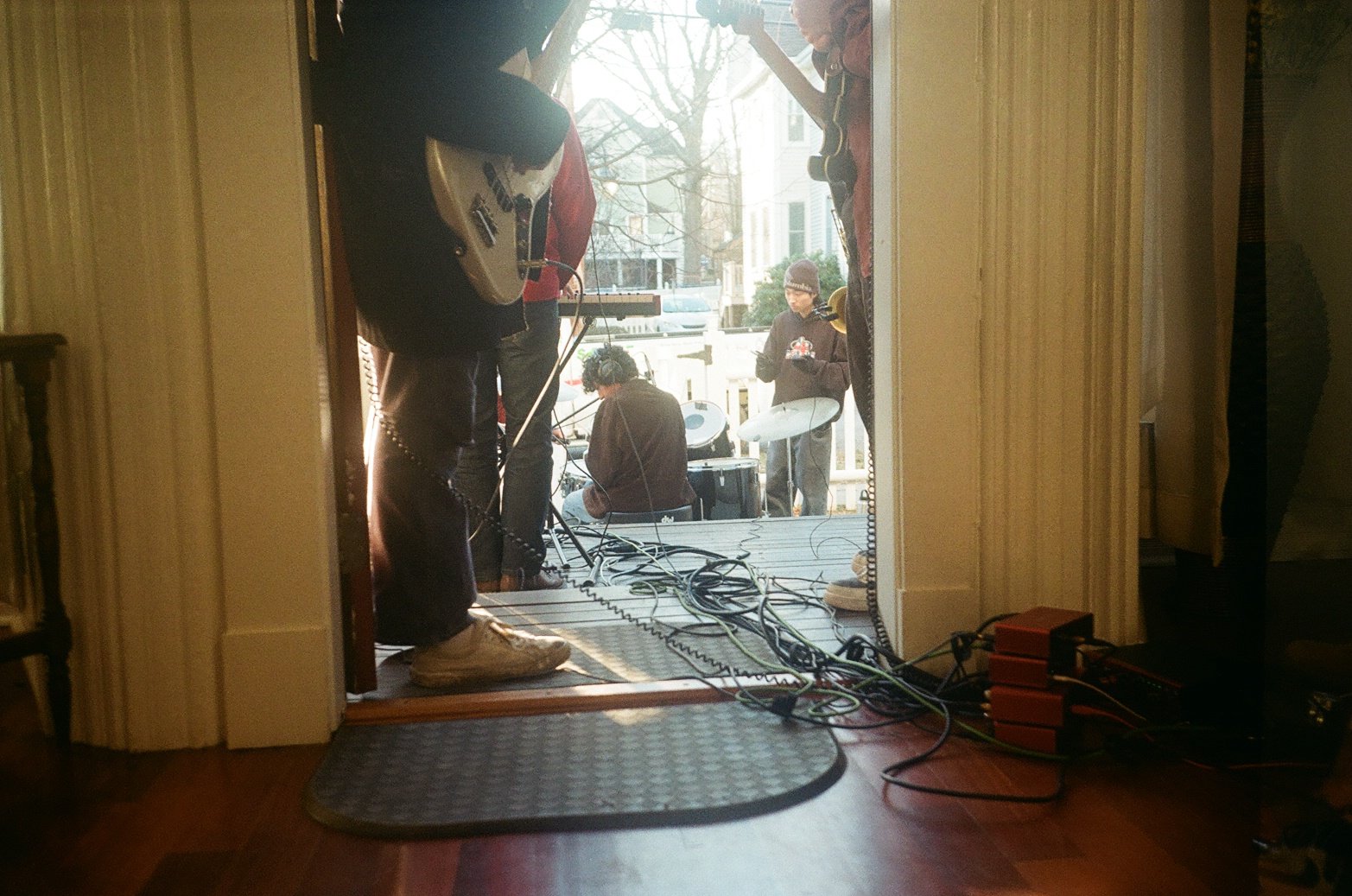Dejima on “Swollen”
Kaveh Hodjat, the mind behind the psychedelic-indie-rock act Dejima (DEH-jihma), describes his work as “something that’s not just film or just music, but something in between.” Hodjat, a 21-year-old film student at Emerson College, has been releasing multi-disciplinary projects under the name Dejima since 2021, but his recent EP marked a turning point in his practice. The project, titled Swollen, saw his far-ranging influences coalesce into an immersive 30-minute music-video-short-film fusion.
Kaveh grew up enjoying the fruits of a musical household, absorbing his father’s CD collection, playing guitar, singing, and learning to play drums at the age of four. During the pandemic, he turned to other instruments, picking up piano, guitar, and bass—and later learned how to piece them all together into music written and recorded from his bedroom. He attributes his love of filmmaking to a hobby he picked up in middle school: making Minecraft videos. He also credits his high school’s robust film program and annual film festival, which he described as being “way bigger than prom.”
The process of making of a multi-song music video strung together by a narrative short film gave Kaveh an opportunity to bring these two passions together. During our interview, Hodjat emphasized the extensive contributions of his creative team. He explained that, while the crew wasn’t always entirely sure how each music video would tie into the short film, to Kaveh, blending Swollen’s pieces felt instinctual. It’s clear that listening to his intuition paid off: Swollen’s textured sound, complex narrative, and lush cinematography harmonize into a truly immersive listening and viewing experience.
Interview by Lucy Belknap, Photos by John Kim and Gabe Mirigian
MISTER
Why did you choose to combine music and film for this project? Were there any particular artists or projects that served as touchstones for you in the making of the Swollen, or was it something that you hadn’t seen before and wanted to create yourself?
KAVEH HODJAT
The vision I had for Swollen was mainly something I hadn’t seen before. It was just a vision. I think the closest thing that I’ve seen was a video that Dijon made with Mk.gee and a few other artists. It’s a 20-minute live performance, and it was close, but it wasn’t exactly what we were going for. There was a narrative component that was missing, and I wanted to bring that side into the equation. Something that binds all these mediums together for me is the urge to tell a story. Whether it’s making a song, a short film, a music video, even merch—I want to tell a story through wearing or watching or hearing.
MISTER
I’ve heard that you wrote the songs on Swollen separately, and only later realized the narrative ties between them. I’m curious to hear more about that process. Where did the ideas behind your songs come from originally? What spurred you to string them all together?
KAVEH HODJAT
My intuition led me to put them in their specific order. I wasn’t ever thinking, “I’m writing this song for an EP.” I was just making music based on how I was feeling. And then I would notice, “Oh, ‘Swollen’ ends with a flute Mellotron sound. ‘It Was Nice To Have Met You’ starts with a flute Mellotron sound—it’d be cool if they go back to back.” And then that just kept happening. I realized that I had an EP right in front of me, just from intuition, and what made sense sonically.
Then I realized that all these songs have to do with some form of frustration. It clicked that this was all from one person’s perspective. For each song, I thought, if I just pretended this was from one person’s point of view about one topic, then there’s such an arc here. What is this person feeling? I ran to one of my managers and close friends, Luke, and we plastered his wall with post it notes and put all the songs and their meanings up. From there, it was just a matter of thinking of a scenario that this “character” is in, and what scenario would make sense for him to go through these emotions in. We landed on the idea of two brothers coming home from college. That’s how the whole story came about.
Still: “Nothing to Run From”
MISTER
In terms of the storyline, the Mister team found it very fascinating that you portrayed that anxiety and frustration you’re talking about through the body, in the form of a physical rash and its spread. Could you talk a little bit more about the thinking behind that choice?
KAVEH HODJAT
It’s something that I do actually deal with—I have chronic urticaria, which causes hives and swelling. Unfortunately, the reason for it is kind of unexplained, so when it does happen, it’s easy to get frustrated. Swollen flips this: what if every time you get frustrated, it happens? It was a way that we could visualize this person’s feelings without him having to say, “I’m frustrated.” It’s also somewhat tangible—you could almost think of it like a character within itself.
One other thing I really like about swelling is that it’s something that you can hide—you could put a bandage on it. You could hide it from someone else. I liked that dynamic. I thought that could symbolize an unhealthy relationship, where they’re hiding information from each other. It’s such a big moment when that flips, because then the person realizes, “Oh, you’ve been hiding it the whole time.”
Still: “Change 4 U”
MISTER
I’d love to hear more about the filming process and what that was like—how it was trying to pull this whole project together with a big group of college students and how you brought your vision to life within the bounds of the limitations you had, whether on time or budget or crew size.
KAVEH HODJAT
That was the trickiest part. We were like: “This is such a good idea. How the hell are we gonna actually pull it off?” Midway through the set, four people had gotten sick already—things were going crazy, and I thought, “Okay, if we just get a cut, if we just finish it, that would be amazing.” I was already so proud of everyone.
There was just so much excitement regarding the project. It felt like people were going to see it, and we were all working for this final vision. It was just a lot of pulling strings. We shot at Luke’s brother’s house in New Hampshire. Transporting everyone was crazy. The way we got our equipment was really funny—I don’t want to get in trouble by saying how we did it, but let’s just say we finessed some of it.
It was a six-, seven-day winter film camp, and it was so fun and so loving, and I was so grateful every single second I was there. But I’ve also never been so exhausted. There was so much to juggle, so it was great to have a team that I could trust so much, and to totally be able to let go and let them do their thing.
MISTER
Yeah, I could see how it’d be a lot of different moving pieces that you have to coordinate by being the center of the project, so it’s really impressive that it was pulled off.
KAVEH HODJAT
Ty and Jeremy, our engineers, figured out this crazy way to get a bunch of entry level audio interfaces, stack them on top of each other, and get all the inputs into one computer, saving us a lot of money and pain. It was working so great. I was like, “You guys are geniuses!”...until it was the last day and it was four degrees out, and I was on the back of a truck recording, and it just failed. Like, just stopped. There’s a video of the whole crew with, like, seven different hair dryers on them. Eventually we got it to work—we snuck all the equipment into the pickup truck and then wired it out—but that was a very stressful day. And that was just one of the days.
Still: “It Was Nice To Have Met You”
MISTER
Our team really loves this piece because we felt it connected very strongly to the themes that we’re trying to center on in this issue, which are heritage, cultural ecology, and art. Could you speak a bit on those themes and how they resonate in your film?
KAVEH HODJAT
The culture and heritage part of it is something that I try to put in all of my movies. I’m Iranian-American and both my parents are immigrants. I cast both of my parents in it, and they speak Farsi—I thought it was more personal to include Farsi.
I was going to cast my actual brother too, but he couldn’t make it, unfortunately. Just to clarify: my actual brother loves the film. He helped me write it—when I was at that stage of piecing everything together, he really helped me. After he watched the first cut, he was like, “Wow, everyone’s going to think we hate each other, probably.” I love my brother. We’re going to work together as actor and director in the future.
Another thing that added a lot of layers to the whole thing— there’s an American flag in every scene. We were shooting in New Hampshire, so it makes sense; there’s an American flag on the house, in the living room. But the family that lives there is this Persian family that’s speaking Farsi—it’s traveling, it’s not home.
My character’s leaving for college, leaving this home, but everyone’s trying to belong in some place, and looking for a sense of belonging on all sides—even the parents






